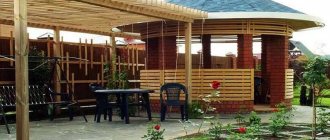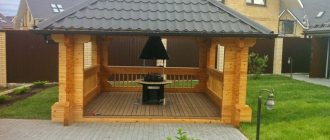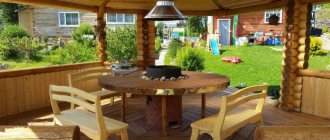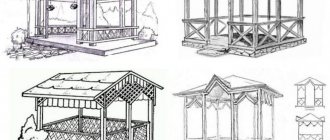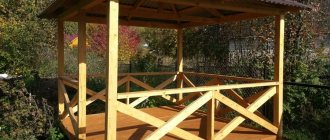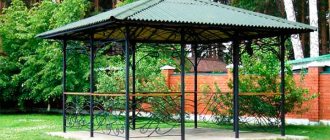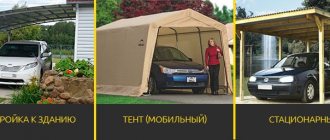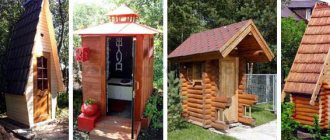The construction of summerhouses made of polycarbonate is becoming increasingly popular. The use of this type of plastic is justified by the excellent characteristics and cost of the material.
Ease of use and a variety of color palettes will help bring any creative idea to life. On the websites of manufacturing companies there are many options for summerhouses made of polycarbonate; you can find photos for inspiration on the Internet. How to choose thermoplastic, which frames to combine with, how to make it yourself? We'll figure out.
Brief overview of the article
- Advantages
- Types of plastic
- Wavy
- Monolithic
- Cellular
- Features of choice
- Material for the frame of the gazebo
- Wood
- Metal
- Plastic
- How to make a gazebo yourself
- Photo of a polycarbonate gazebo
Advantages
Polycarbonate owes its appearance to Israeli chemists. As a result of the research, strong and durable plastic was obtained with great prospects for use in construction. Canopies, awnings, billboards, greenhouses, greenhouses and even barriers on the road - this is not the entire list of structures made from this material.
Let's consider the advantages:
- light weight - 2 times lighter than glass. This gives an advantage when building a gazebo: there is no need to pour a foundation;
- strength – able to withstand the weight of precipitation;
- excellent transparency - no additional lighting required indoors;
- good heat and sound insulation;
- resistance to temperature changes;
- unpretentious in care - not susceptible to aggressive abrasives;
- easy to use and install;
- universal - combined with wood, metal and plastic;
- low cost.
It is for these qualities that summer residents value polycarbonate so highly. It is actively used for cladding structures, forming roofs, constructing sound screens and protective canopies. You can watch video tutorials on how to make a gazebo from polycarbonate.
What kind of roof can you build?
Single-pitch
The simplest, cheapest and most popular option. The gazebo is covered with several sheets, which are attached to the roof at an angle and provide reliable and practical protection.
This option is far from those aesthetic architectural masterpieces of expensive gazebos, but it is quite applicable for almost any building.
Single-pitch option
Gable
A relatively simple structure that will not be difficult to build on your own
It will be important to correctly select the angle of inclination on both sides, which should be at least 6 degrees so that the entire structure looks harmonious
Gable
Four-slope
This option belongs to a more complex type. You will have to invest a lot of time in disassembling the structure and installing sheets on the rafter system.
a9a7d3eefd53ab2a7e5fa81a1c0d712e.jpe
bf4429fb78576d02cce8ed1254739b60.jpe
The process of erecting a “steeper” hip roof looks even more complicated, but possible. If you follow the instructions and do not skimp on materials and quality of construction, then everything will turn out better.
Four-slope
Hexagon
In this case, difficulties already arise with the polycarbonate itself, which needs to be correctly measured and cut. There will be problems with the construction of the roof, since it will be difficult to make it even on all edges (but possible!).
This option can also be implemented with your own hands without any special knowledge and experience.
Hexagonal (hexagonal)
Arched
In the case of an arched shape, you will have to bend the polycarbonate to attach to the rafters.
Here it is important to understand the specifics of polycarbonate - it gains the greatest rigidity when it is curved downward in honeycombs, and condensation does not accumulate in them due to this direction. Otherwise, when bending, you can simply ruin the material
Arched
Dome (round)
The pinnacle of architectural thought in this publication is the domed shape of the carbonate roof. Few summer residents dare to use a similar roof format, since this process is quite complex and risky.
However, if you decide to sculpt a similar form from polycarbonate, follow the instructions of experienced builders, otherwise by the end of construction you will have neither a roof nor building material left :).
Dome blue
Cellular
The sheet consists of two layers connected to each other by jumpers - stiffening ribs. It is because of its structure that polycarbonate got its name. Thanks to this production technology, plastic acquires the property of increased impact resistance and low thermal conductivity.
When using it, it is necessary to take into account that the sheets have a significant drawback: at low temperatures it loses its plasticity and cracks. But you can avoid this trouble by covering the surface with a protective film.
Features of choice
In order not to make a mistake with the thickness and number of sheets, it is necessary to take into account the functions and dimensions of the gazebo. Depending on the intended tasks, the type and color of polycarbonate is selected.
By correctly calculating the footage required for construction, you can avoid unnecessary waste when trimming and save your budget. When creating bent elements, be sure to read the manufacturer's recommendations indicating the maximum allowable bending radius.
It would be a good idea to compare the thickness of the sheets with the expected loads. So, an 8 mm sheet can withstand a layer of snow and withstand temperature changes. While the use of 4 mm will be justified in the construction of small structures.
An important indicator of the quality of a polymer will be its cost: it is unlikely that a cheap one will meet your requirements. Also, do not hesitate to bend the sheet with your hands and hold it up to the light: manufacturing defects can cause the structure to become frail.
Construction prices in companies
If opportunities allow, then it is worth purchasing a ready-made version of the structure of various designs and sizes, or buying individual elements and assembling it yourself. You can also order production according to an individual project.
Photo: metal profiles and polycarbonate in skillful hands turn into an excellent place to relax
You can get acquainted with the assortment, prices and make a purchase through online stores or by contacting the office of the construction organization.
The cost of 1 m2 of monolithic polycarbonate is from 750 rubles, cellular - from 160 rubles.
How much the finished structure will cost depends on the consumption of materials, shape, finishing elements, delivery distance and manufacturer. The price for a summerhouse 1.7 m wide, 3 m long, 2.2 m high starts from 16,000 rubles or 6,500 UAH. But a gazebo-swing will cost 25 thousand rubles (10 thousand UAH) and more.
Owners who want to bring to life the idea of creating an unusual building on their site can use the help of specialists or rely on their own strength. The main thing is that the end result is pleasing to the eye and brings pleasure.
Wood
When creating a structure, I use rounded timber or boards. Aesthetic appearance, naturalness and environmental friendliness are the main advantages of buildings.
However, regular maintenance: antiseptic coating and painting make operation difficult. Unfortunately, without these measures, the wood will quickly rot and the service life of the gazebo will be significantly reduced.
Design work
Now it’s worth deciding on some details regarding the arrangement of a gazebo on a summer cottage. And the chosen location will play an important role. In this case, it is necessary to take into account the following details:
- Rose of Wind;
- nearby trees and shrubs and the level of shadow from them;
- presence of uneven ground;
- whether there is a slope or mostly flat.
Regardless of the chosen location, it is important to carry out all the preparatory work to clean and prepare it. To do this, also think about this:
- what will be the total weight of the structure;
- what level of difficulty;
- dimensions of the building.
It is important to think through all these subtleties in advance, because this will be influenced by the choice of a specific material for making the frame.
Metal
Gazebos made of metal and polycarbonate are durable, but also require maintenance, as they are susceptible to corrosion. Having a welding machine, you can create a pavilion with curved lines and decorative elements.
The need for a foundation
If, according to the diagram, the future gazebo will have a massive appearance, and a combination of polycarbonate with wood or brick will be used as the main materials, then laying the foundation is a mandatory stage in assembling the structure. A columnar or shallow strip base is suitable. For a closed type of gazebo with a fireplace, barbecue or barbecue inside, you can pour a monolith. In addition, a separate foundation is created for the heating product.
But for lightweight buildings, you can get by with installing supporting pipes. They will become a simple but strong foundation of the structure.
How to make a gazebo yourself
Polycarbonate is so easy to use that you can handle it with a minimum set of carpentry skills. The main thing here is to already have a ready-made frame (drawings of the gazebo, by the way, can be found on the Internet).
So, after you have decided on the scope of work and drawn up a diagram with dimensions, we begin:
We clear the area for work and lay out a sheet of polycarbonate. We apply markings in accordance with the dimensions of the frame.
Let's start cutting. For an even cut, use a jigsaw. We seal the cuts (to protect them from destruction).
Let's start assembly. Here it is important to pay attention to the fact that one of the sides of the sheet will be covered with a protective film and is resistant to UV rays - this is the outer part. Two installation methods can be used:
- We fasten the workpieces to the base with self-tapping screws and thermal washers. Don’t forget to seal the fastening points with sealant;
- We use special profiles: straight or angular.
We carry out work from the bottom up.
Roof covering work has its own nuances, but in general they are similar:
- it is important to set the required angle of inclination;
- seams and joints must be sealed with sealant or waterproof tape;
- When sheathing with cellular polycarbonate, place the cells along the length of the sheet.
A DIY polycarbonate gazebo is a great and inexpensive way to show creativity and practice before a larger construction project.
Selection of material
Polycarbonate is practical and has high mechanical strength. The plastic is resistant to sudden temperature changes (from -40 ◦C to +120 ◦C). It protects well from ultraviolet radiation. The throughput of this material reaches 80%.
A gazebo with a polycarbonate roof is not afraid of precipitation such as hail, wind, snow and rain. To assemble the structure, you do not need special tools or special skills.
Plastic is a budget material. It can be cut, drilled and bent. It comes in two types: cellular and monolithic. To create country and garden gazebos, the first variety is most often used. This is due to its lower cost, weight and flexibility.
Closed gazebos are not made from cellular polycarbonate, which is explained by the ability of this plastic to concentrate heat. In this case, the cellular coating will have to be replaced with a monolithic one.
